人教版七年级下册英语 连词成句 上教学提纲
- 格式:doc
- 大小:17.50 KB
- 文档页数:4
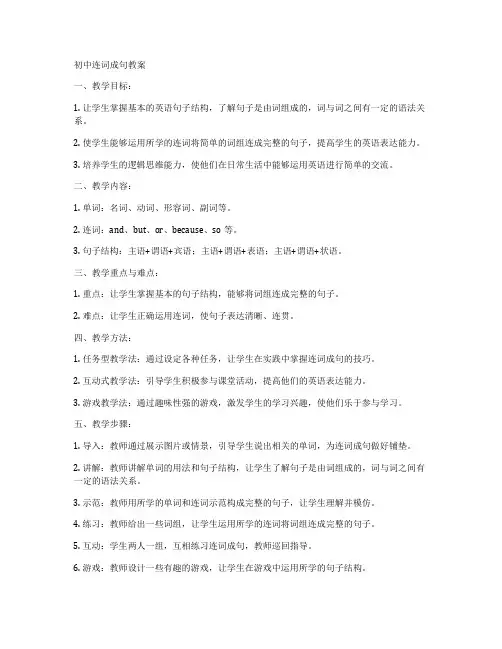
初中连词成句教案一、教学目标:1. 让学生掌握基本的英语句子结构,了解句子是由词组成的,词与词之间有一定的语法关系。
2. 使学生能够运用所学的连词将简单的词组连成完整的句子,提高学生的英语表达能力。
3. 培养学生的逻辑思维能力,使他们在日常生活中能够运用英语进行简单的交流。
二、教学内容:1. 单词:名词、动词、形容词、副词等。
2. 连词:and、but、or、because、so等。
3. 句子结构:主语+谓语+宾语;主语+谓语+表语;主语+谓语+状语。
三、教学重点与难点:1. 重点:让学生掌握基本的句子结构,能够将词组连成完整的句子。
2. 难点:让学生正确运用连词,使句子表达清晰、连贯。
四、教学方法:1. 任务型教学法:通过设定各种任务,让学生在实践中掌握连词成句的技巧。
2. 互动式教学法:引导学生积极参与课堂活动,提高他们的英语表达能力。
3. 游戏教学法:通过趣味性强的游戏,激发学生的学习兴趣,使他们乐于参与学习。
五、教学步骤:1. 导入:教师通过展示图片或情景,引导学生说出相关的单词,为连词成句做好铺垫。
2. 讲解:教师讲解单词的用法和句子结构,让学生了解句子是由词组成的,词与词之间有一定的语法关系。
3. 示范:教师用所学的单词和连词示范构成完整的句子,让学生理解并模仿。
4. 练习:教师给出一些词组,让学生运用所学的连词将词组连成完整的句子。
5. 互动:学生两人一组,互相练习连词成句,教师巡回指导。
6. 游戏:教师设计一些有趣的游戏,让学生在游戏中运用所学的句子结构。
7. 总结:教师对本节课的内容进行总结,强调重点和难点。
8. 作业:教师布置一些相关的作业,让学生巩固所学知识。
六、教学评价:1. 课堂参与度:观察学生在课堂上的积极参与程度,了解他们的学习兴趣。
2. 作业完成情况:检查学生作业的完成情况,了解他们掌握连词成句的程度。
3. 课后反馈:与学生家长沟通,了解学生在家的学习效果,以便更好地指导教学。
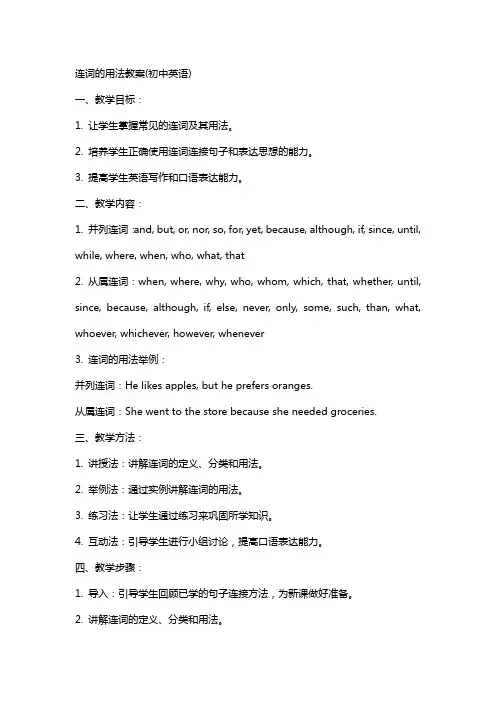
连词的用法教案(初中英语)一、教学目标:1. 让学生掌握常见的连词及其用法。
2. 培养学生正确使用连词连接句子和表达思想的能力。
3. 提高学生英语写作和口语表达能力。
二、教学内容:1. 并列连词:and, but, or, nor, so, for, yet, because, although, if, since, until, while, where, when, who, what, that2. 从属连词:when, where, why, who, whom, which, that, whether, until, since, because, although, if, else, never, only, some, such, than, what, whoever, whichever, however, whenever3. 连词的用法举例:并列连词:He likes apples, but he prefers oranges.从属连词:She went to the store because she needed groceries.三、教学方法:1. 讲授法:讲解连词的定义、分类和用法。
2. 举例法:通过实例讲解连词的用法。
3. 练习法:让学生通过练习来巩固所学知识。
4. 互动法:引导学生进行小组讨论,提高口语表达能力。
四、教学步骤:1. 导入:引导学生回顾已学的句子连接方法,为新课做好准备。
2. 讲解连词的定义、分类和用法。
3. 举例说明连词的用法,让学生理解并区分并列连词和从属连词。
4. 开展小组讨论,让学生运用连词连接句子,分享自己的成果。
5. 布置练习题,让学生巩固所学知识。
五、课后作业:1. 抄写本节课讲解的连词及其用法。
2. 完成课后练习题,提高连词运用能力。
3. 结合所学知识,尝试在写作和口语表达中运用连词。
六、教学评价:1. 课堂参与度:观察学生在课堂上的积极参与情况,以及对连词用法的理解和运用。
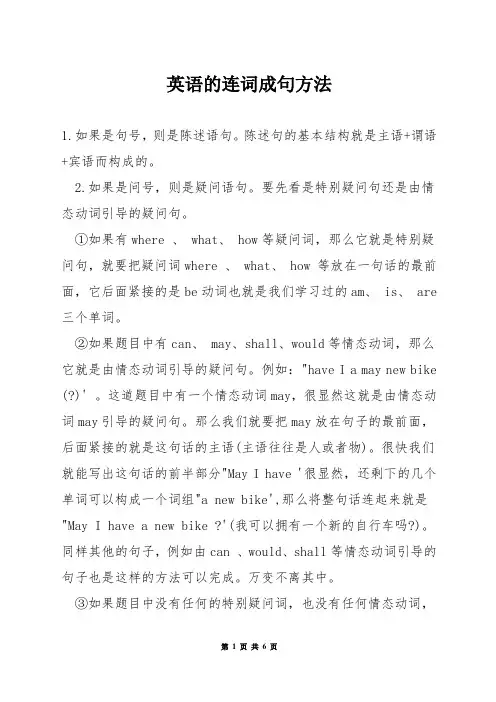
英语的连词成句方法1.如果是句号,则是陈述语句。
陈述句的基本结构就是主语+谓语+宾语而构成的。
2.如果是问号,则是疑问语句。
要先看是特别疑问句还是由情态动词引导的疑问句。
①如果有where 、 what、 how等疑问词,那么它就是特别疑问句,就要把疑问词where 、 what、 how 等放在一句话的最前面,它后面紧接的是be动词也就是我们学习过的am、 is、 are 三个单词。
②如果题目中有can、 may、shall、would等情态动词,那么它就是由情态动词引导的疑问句。
例如:"have I a may new bike (?)' 。
这道题目中有一个情态动词may,很显然这就是由情态动词may引导的疑问句。
那么我们就要把may放在句子的最前面,后面紧接的就是这句话的主语(主语往往是人或者物)。
很快我们就能写出这句话的前半部分"May I have '很显然,还剩下的几个单词可以构成一个词组"a new bike',那么将整句话连起来就是"May I have a new bike ?'(我可以拥有一个新的自行车吗?)。
同样其他的句子,例如由can 、would、shall等情态动词引导的句子也是这样的方法可以完成。
万变不离其中。
③如果题目中没有任何的特别疑问词,也没有任何情态动词,那么它就是我们最最熟悉的一般疑问句了。
这样的题目应该是同学的拿手好戏。
例如:"you a are student(?)'.很显然是一个疑问句,而且没有任何特别疑问词。
所以这是一句一般疑问句,一般疑问句的基本准则就是疑问词是be动词(am /is/are),而且要把它们放在句子的最前面。
通过观察我们看到题目中有一个be动词(are),所以这句话就很容易连到"Are you a student ?'(你是一个同学吗?)。
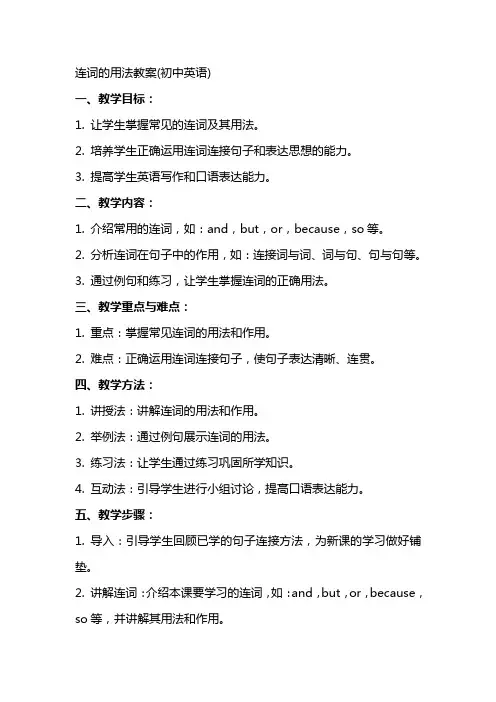
连词的用法教案(初中英语)一、教学目标:1. 让学生掌握常见的连词及其用法。
2. 培养学生正确运用连词连接句子和表达思想的能力。
3. 提高学生英语写作和口语表达能力。
二、教学内容:1. 介绍常用的连词,如:and,but,or,because,so等。
2. 分析连词在句子中的作用,如:连接词与词、词与句、句与句等。
3. 通过例句和练习,让学生掌握连词的正确用法。
三、教学重点与难点:1. 重点:掌握常见连词的用法和作用。
2. 难点:正确运用连词连接句子,使句子表达清晰、连贯。
四、教学方法:1. 讲授法:讲解连词的用法和作用。
2. 举例法:通过例句展示连词的用法。
3. 练习法:让学生通过练习巩固所学知识。
4. 互动法:引导学生进行小组讨论,提高口语表达能力。
五、教学步骤:1. 导入:引导学生回顾已学的句子连接方法,为新课的学习做好铺垫。
2. 讲解连词:介绍本课要学习的连词,如:and,but,or,because,so等,并讲解其用法和作用。
3. 示例:用所学的连词连接词或句子,展示连词的实际运用。
4. 练习:让学生通过填空、改写等形式的练习,巩固所学连词的用法。
5. 互动:分组进行讨论,让学生运用所学连词进行句子连接,培养口语表达能力。
6. 总结:对本课所学内容进行总结,强调连词在句子中的重要作用。
7. 作业:布置相关的写作或口语作业,让学生进一步巩固所学知识。
六、教学拓展:1. 介绍连词的分类:并列连词、从属连词、并列副词等。
2. 分析不同类型连词的用法和作用。
3. 通过例句和练习,让学生掌握各类连词的正确用法。
七、课堂活动:1. 举办连词用法竞赛,激发学生学习兴趣。
2. 学生分组进行竞赛,培养团队协作能力。
3. 教师点评竞赛结果,对学生的优点进行表扬,对不足之处进行指导。
八、课后作业:1. 让学生运用所学连词,完成一篇小作文。
2. 要求作文内容连贯、条理清晰,运用适当的连词。
3. 教师批改作文,对学生的写作能力进行评价,并提出改进意见。
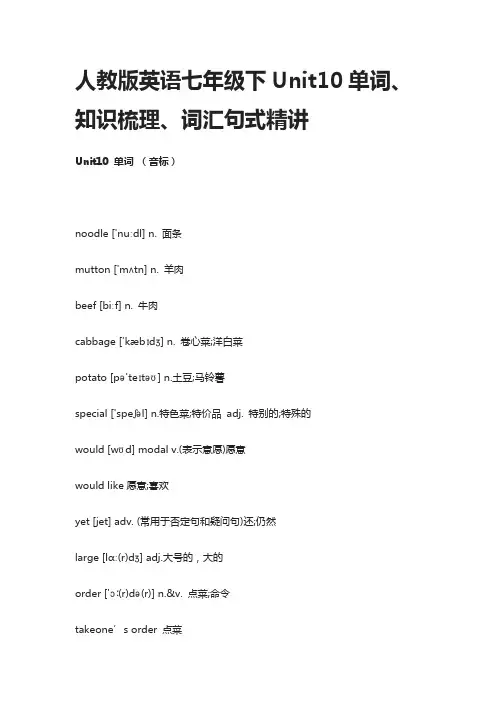
人教版英语七年级下Unit10单词、知识梳理、词汇句式精讲Unit10 单词(音标)noodle ['nuːdl] n. 面条mutton ['mʌtn] n. 羊肉beef [biːf] n. 牛肉cabbage ['kæbɪdʒ] n. 卷心菜;洋白菜potato [pə'teɪtəʊ] n.土豆;马铃薯special ['speʃəl] n.特色菜;特价品adj. 特别的;特殊的would [wʊd] modal v.(表示意愿)愿意would like愿意;喜欢yet [jet] adv. (常用于否定句和疑问句)还;仍然large [lɑː(r)dʒ] adj.大号的,大的order ['ɔː(r)də(r)] n.&v. 点菜;命令takeone’s order 点菜size [saɪz] n. 大小;尺码bowl [bəʊl] n. 碗one(large) bowl of…一(大)碗tofe [təʊfu:] n. 豆腐meat [miːt] n. (可食用的)肉dumpling ['dʌmplɪŋ] n.饺子porridge ['pɒrɪdʒ] n. 粥;面糊onion ['ʌnjən] n. 洋葱fish [fɪʃ] n. 鱼;鱼肉pancake ['pænkeɪk] 烙饼;薄饼world [wɜː(r)ld] n. 世界aroundthe world世界各地answer ['ɑːnsə] v. 回答n. 答案different ['dɪfərənt] adj.不同的cake [keɪk] n. 蛋糕candle ['kændl] n. 蜡烛age [eɪdʒ] n. 年龄makea wish许愿blow [bləʊ] v. 吹blowout吹灭if [ɪf] conj. 如果will [wɪl] v. 将要;会the UK(=theUnited Kingdom) [,ju:’keɪ]([jʊ'naɪtɪd ‘kɪŋdəm]) n.英国candy ['kændi] n. 糖果lucky ['lʌki] adj. 幸运的popular ['pɒpjʊlə] adj.受欢迎的;普遍的getpopular受欢迎;流行cutup切碎idea [aɪ'dɪə] n.想法;主意bring good luck to…给……带来好运Unit10 知识梳理【重点短语】1. would like sth. 想要某物2. would like to do sth. 想要做某事3. put on 穿上,戴上4. take one’s order 点菜5. in the beef noodles 在牛肉面里6. mapo tofu with rice麻婆豆腐外带大米7. what kind of noodles什么种类的面条8. a large bowl of noodles一大碗面条9. a medium bowl of noodles 一中碗面10. a small bowl of noodles 一小碗面条11. what size 什么尺寸12.May I take your order? 可以点餐了么?13. beef noodles with carrots带有胡萝卜的牛肉面14. green tea 绿茶15. orange juice 橙汁16. around the world 世界各地17. in different countries 在不同的国家18. birthday cakes with candles带蜡烛的生日蛋糕19. the birthday person 寿星20.make a wish 许愿21. blow out the candles 吹灭蜡烛22. in one go 一口气,一次性的23. come true 实现24. get popular 变得流行,受欢迎25. long noodles 长寿面26. cut up 切碎/断27. a symbol of long life 长寿的象征28. be different 不同的29. be the same 一样的30. bring good luck to sb. 带给某人幸运31. have different kinds of …有不同种类的......【重点句型】1. What would you like?您需要什么?2. I'm not sure yet. Are there any vegetables in the beef noodles? 我不确定,牛肉面里有蔬菜吗?3. Yes, there are some tomatoes.有,里面有西红柿。
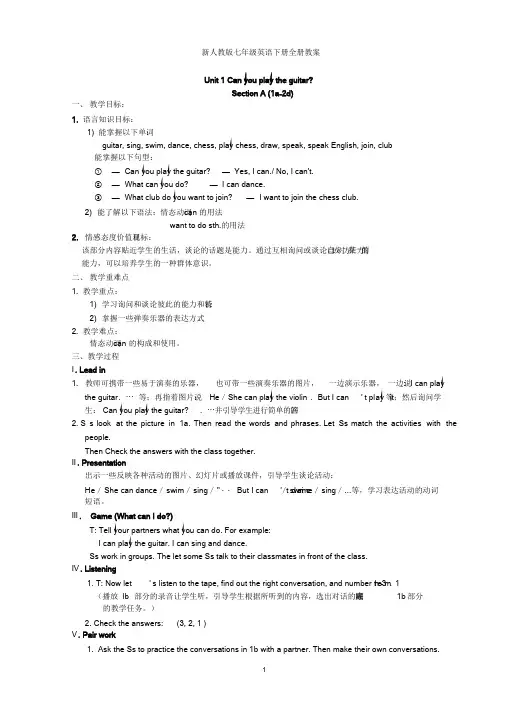
新人教版七年级英语下册全册教案Unit 1 Can you play the guitar?Section A (1a-2d)一、教学目标:1. 语言知识目标:1) 能掌握以下单词:guitar, sing, swim, dance, chess, play chess, draw, speak, speak English, join, club 能掌握以下句型:①—Can you play the guitar? —Yes, I can./ No, I can't.②—What can you do? —I can dance.③—What club do you want to join? —I want to join the chess club.2) 能了解以下语法:情态动词c an 的用法want to do sth.的用法2.情感态度价值观目标:的某一方面己或对方在该部分内容贴近学生的生活,谈论的话题是能力。
通过互相询问或谈论自能力,可以培养学生的一种群体意识。
二、教学重难点1. 教学重点:1) 学习询问和谈论彼此的能力和特长;2) 掌握一些弹奏乐器的表达方式。
2. 教学难点:c an 的构成和使用。
情态动词三、教学过程Ⅰ. Lead in1. 教师可携带一些易于演奏的乐器,也可带一些演奏乐器的图片,一边演示乐器,一边说:I can playthe guitar.⋯等;再指着图片说:He/She can play the violin .But I can ’t pl.a y等it;然后询问学。
生:Can you play the guitar? .⋯并引导学生进行简单的回答2. S s look at the picture in 1a. Then read the words and phrases. Let Ss match the activities with thepeople.Then Check the answers with the class together.Ⅱ. Presentation出示一些反映各种活动的图片、幻灯片或播放课件,引导学生谈论活动:He/She can dance/swim/sing/" ··But I can ’/t s d w a n i m c e/sing/...等,学习表达活动的动词短语。
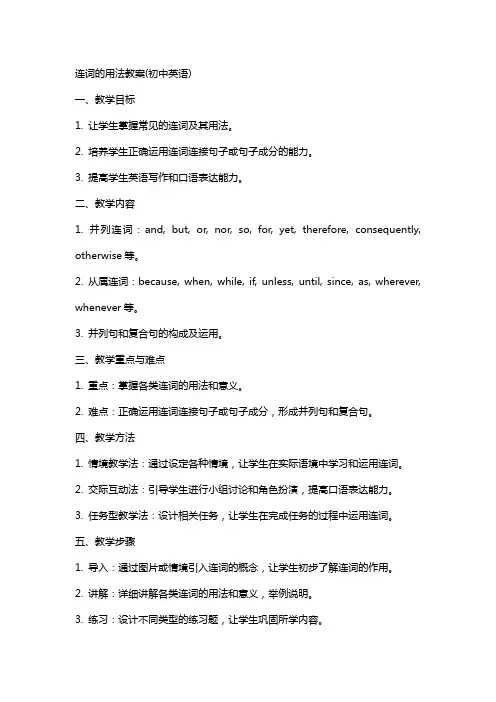
连词的用法教案(初中英语)一、教学目标1. 让学生掌握常见的连词及其用法。
2. 培养学生正确运用连词连接句子或句子成分的能力。
3. 提高学生英语写作和口语表达能力。
二、教学内容1. 并列连词:and, but, or, nor, so, for, yet, therefore, consequently, otherwise等。
2. 从属连词:because, when, while, if, unless, until, since, as, wherever, whenever等。
3. 并列句和复合句的构成及运用。
三、教学重点与难点1. 重点:掌握各类连词的用法和意义。
2. 难点:正确运用连词连接句子或句子成分,形成并列句和复合句。
四、教学方法1. 情境教学法:通过设定各种情境,让学生在实际语境中学习和运用连词。
2. 交际互动法:引导学生进行小组讨论和角色扮演,提高口语表达能力。
3. 任务型教学法:设计相关任务,让学生在完成任务的过程中运用连词。
五、教学步骤1. 导入:通过图片或情境引入连词的概念,让学生初步了解连词的作用。
2. 讲解:详细讲解各类连词的用法和意义,举例说明。
3. 练习:设计不同类型的练习题,让学生巩固所学内容。
4. 小组讨论:学生分组讨论,运用连词编写句子或短文。
5. 展示:各小组展示讨论成果,其他学生进行评价和补充。
7. 作业布置:布置相关作业,让学生进一步巩固所学知识。
六、教学拓展1. 引导学生了解连词在英语语法中的地位和作用。
2. 介绍连词的分类及其用法,如并列连词、从属连词、副词连词等。
3. 举例讲解连词在复杂句子结构中的应用,如并列句、复合句、并列复合句等。
七、课堂活动1. 开展连词接龙游戏,让学生在轻松愉快的氛围中学习连词。
2. 组织学生进行英语角活动,运用所学连词进行口语交流。
3. 举办连词用法竞赛,激发学生学习兴趣,提高运用能力。
八、教学评价1. 课堂参与度:观察学生在课堂活动中的积极参与情况和表现。
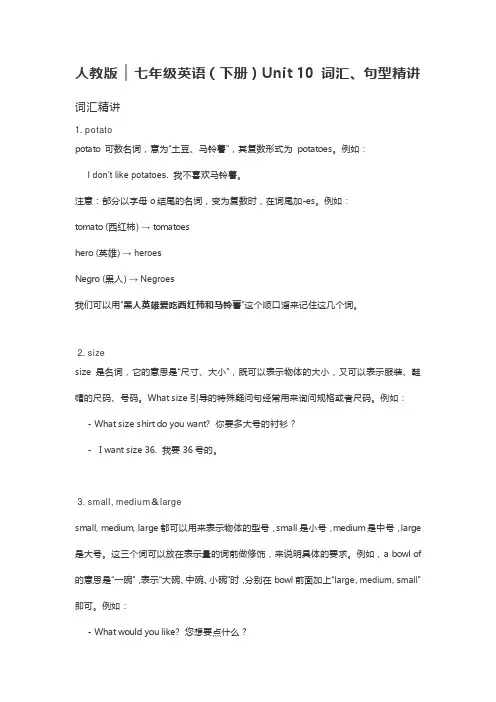
人教版▏七年级英语(下册)Unit 10 词汇、句型精讲词汇精讲1. potatopotato 可数名词,意为“土豆、马铃薯”,其复数形式为potatoes。
例如:I don’t like potatoes. 我不喜欢马铃薯。
注意:部分以字母o结尾的名词,变为复数时,在词尾加-es。
例如:tomato (西红柿) → tomatoeshero (英雄) → heroesNegro (黑人) → Negroes我们可以用“黑人英雄爱吃西红柿和马铃薯”这个顺口溜来记住这几个词。
2. sizesize是名词,它的意思是“尺寸、大小”,既可以表示物体的大小,又可以表示服装、鞋帽的尺码、号码。
What size引导的特殊疑问句经常用来询问规格或者尺码。
例如:-What size shirt do you want? 你要多大号的衬衫?-I want size 36. 我要36号的。
3. small, medium&largesmall, medium, large都可以用来表示物体的型号,small是小号,medium是中号,large 是大号。
这三个词可以放在表示量的词前做修饰,来说明具体的要求。
例如,a bowl of 的意思是“一碗”,表示“大碗、中碗、小碗”时,分别在bowl前面加上“large, medium, small”即可。
例如:-What would you like? 您想要点什么?-I’d like a large bowl o f beef noodles. 我要一大碗牛肉面。
4. special(1)special作名词时,意为“特色菜、特价品、特别的事物”等。
例如:The train is a special for the football game.那班火车是为足球赛开的专车。
The menu changes regularly and there are daily specials to choose from.菜谱定期更换,而且每天都有特色菜供选择。
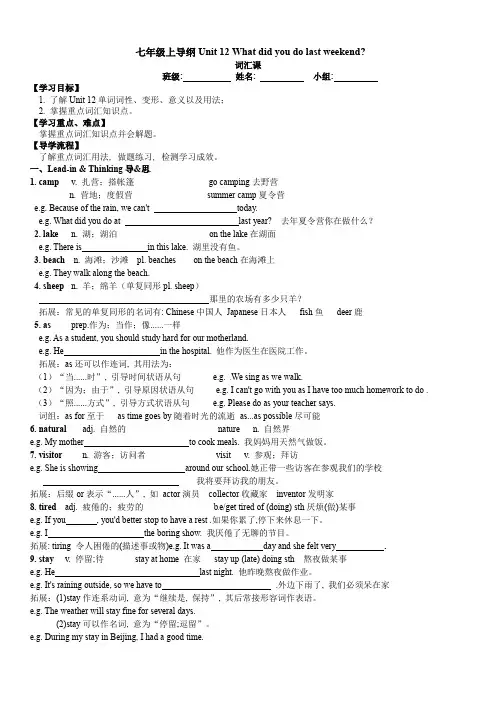
七年级上导纲Unit 12 What did you do last weekend?词汇课班级: 姓名: 小组:【学习目标】1. 了解Unit 12单词词性、变形、意义以及用法;2. 掌握重点词汇知识点。
【学习重点、难点】掌握重点词汇知识点并会解题。
【导学流程】了解重点词汇用法, 做题练习, 检测学习成效。
一、Lead-in & Thinking导&思1. camp v. 扎营;搭帐篷go camping去野营n. 营地;度假营summer camp夏令营e.g. Because of the rain, we can't today.e.g. What did you do at last year? 去年夏令营你在做什么?2. lake n. 湖;湖泊on the lake在湖面e.g. There is in this lake. 湖里没有鱼。
3. beach n. 海滩;沙滩pl. beaches on the beach在海滩上e.g. They walk along the beach.4. sheep n. 羊;绵羊(单复同形pl. sheep)那里的农场有多少只羊?拓展:常见的单复同形的名词有: Chinese中国人Japanese日本人fish鱼deer鹿5. as prep.作为;当作;像......一样e.g. As a student, you should study hard for our motherland.e.g. He in the hospital. 他作为医生在医院工作。
拓展:as还可以作连词, 其用法为:(1)“当......时”, 引导时间状语从句 e.g. We sing as we walk.(2)“因为;由于”, 引导原因状语从句 e.g. I can't go with you as I have too much homework to do .(3)“照......方式”, 引导方式状语从句 e.g. Please do as your teacher says.词组:as for至于as time goes by随着时光的流逝as...as possible尽可能6. natural adj. 自然的nature n. 自然界e.g. My mother to cook meals. 我妈妈用天然气做饭。
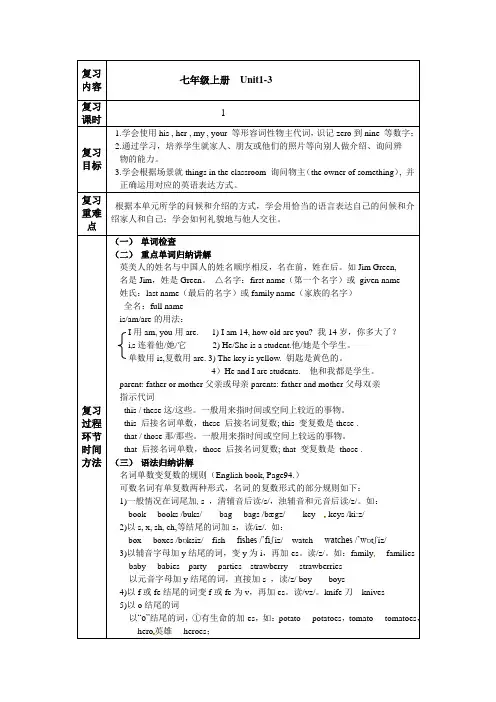
复习内容七年级上册Unit1-3复习课时1复习目标1.学会使用his , her , my , your 等形容词性物主代词,识记zero到nine 等数字;2.通过学习,培养学生就家人、朋友或他们的照片等向别人做介绍、询问辨物的能力。
3.学会根据场景就things in the classroom 询问物主(the owner of something), 并正确运用对应的英语表达方式。
复习重难点根据本单元所学的问候和介绍的方式,学会用恰当的语言表达自己的问候和介绍家人和自己;学会如何礼貌地与他人交往。
复习过程环节时间方法(一)单词检查(二)重点单词归纳讲解英美人的姓名与中国人的姓名顺序相反,名在前,姓在后。
如Jim Green,名是Jim,姓是Green。
△名字:first name(第一个名字)或given name姓氏:last name(最后的名字)或family name(家族的名字)全名:full nameis/am/are的用法:I用am, you用are. 1) I am 14, how old are you? 我14岁,你多大了?i s连着他/她/它2) He/She is a student.他/她是个学生。
单数用is,复数用are. 3) The key is yellow. 钥匙是黄色的。
4)He and I are students. 他和我都是学生。
parent: father or mother父亲或母亲parents: father and mother父母双亲指示代词this / these这/这些。
一般用来指时间或空间上较近的事物。
this 后接名词单数,these 后接名词复数; this 变复数是these .that / those那/那些。
一般用来指时间或空间上较远的事物。
that 后接名词单数,those 后接名词复数; that 变复数是those .(三)语法归纳讲解名词单数变复数的规则(English book, Page94.)可数名词有单复数两种形式,名词的复数形式的部分规则如下:1)一般情况在词尾加-s ,清辅音后读/s/,浊辅音和元音后读/z/。
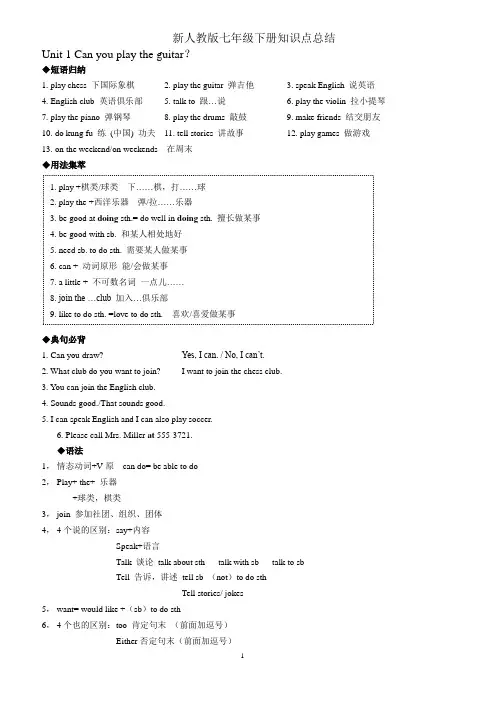
新人教版七年级下册知识点总结Unit 1 Can you play the guitar?◆短语归纳1. play chess 下国际象棋2. play the guitar 弹吉他3. speak English 说英语4. English club 英语俱乐部5. talk to 跟…说6. play the violin 拉小提琴7. play the piano 弹钢琴8. play the drums 敲鼓9. make friends 结交朋友10. do kung fu 练(中国) 功夫11. tell stories 讲故事12. play games 做游戏13. on the weekend/on weekends 在周末◆用法集萃1. play +棋类/球类下……棋,打……球2. play the +西洋乐器弹/拉……乐器3. be good at doing sth.= do well in doing sth. 擅长做某事4. be good with sb. 和某人相处地好5. need sb. to do sth. 需要某人做某事6. can + 动词原形能/会做某事7. a little + 不可数名词一点儿……8. join the …club 加入…俱乐部9. like to do sth. =love to do sth. 喜欢/喜爱做某事◆典句必背1. Can you draw? Yes, I can. / No, I can’t.2. What club do you want to join? I want to join the chess club.3. You can join the English club.4. Sounds good./That sounds good.5. I can speak English and I can also play soccer.6. Please call Mrs. Miller at 555-3721.◆语法1,情态动词+V原can do= be able to do2,Play+ the+ 乐器+球类,棋类3,join 参加社团、组织、团体4,4个说的区别:say+内容Speak+语言Talk 谈论talk about sth talk with sb talk to sbTell 告诉,讲述tell sb (not)to do sthTell stories/ jokes5,want= would like +(sb)to do sth6,4个也的区别:too 肯定句末(前面加逗号)Either否定句末(前面加逗号)Also 行前be 后As well 口语中(前面不加逗号)7,be good at+ V-ing=do well in 擅长于be good for 对…有益(be bad for对…有害)be good to 对…友好(good 可用friendly,nice,kind替换)be good with和…相处好=get on/ along well with8,特殊疑问句的构成:疑问词+一般疑问句9,How/ what about+V-ing …怎么样?(表建议)10,感官动词(look, sound, taste, smell, feel)+adj/ like11,选择疑问句:回答不能直接用Yes或者No,要从中选择一个回答12,students wanted for school show(wanted表示招募,含有被动意义)13,show sth to sb=show sb sth give sth to sb=give sb sth14,help sb (to)do sthHelp sb with sthWith sb’s help= with the help of sbHelp oneself to 随便享用15,be busy doing sth/ be busy with sth16,need to do sth17,be free= have time18,have friends= make friends19,call sb at +电话号码20,on the weekend= on weekends21,English-speaking students 说英语的学生(带有连词符,有形容词性质)22,do kung fu表演功夫◆话题写作Dear Sir,I want to join your organization (组织) to help kids with sports, music and English. My name is Mike. I am 15 years old. I’m a student in No. 1 Middle school. I can play the guitar well. I can sing many songs. I can swim and speak English well, too. I think I can be good with the kids. I also do well in telling stories.I hope to get your letter soon.Yours,MikeUnit 2 What time do you go to school?1,问时间用what time或者whenAt+钟点at 7 o’clock at noon/ at night(during/ in the day)On+ 具体某天、星期、特指的一天on April 1st on Sunday on a cold winter morningIn +年、月、上午、下午、晚上2,时间读法:顺读法逆读法:分钟≤30用past five past eight(8:05)half past eight(8:30)分钟>30用to a quarter to ten(9:45)整点用…o’clock 7 o’clock(7:00)3,3个穿的区别:wear 表状态,接服装、手套、眼镜、香水等Put on 表动作,接服装Dress 表动作,接sb./ oneself get dressed穿衣3,感叹句:How+adj.+主谓!How+adj.+a/an +n单+主谓!What+ a/an +adj.+ n单+主谓!What+ adj.+ n复/ 不可数+主谓!4,from…to…5,be/ arrive late for6,频度副词(行前be 后)always usually often sometimes seldom hardly never7,一段时间前面要用介词forfor half an hour for five minutes8,eat/ have…for breakfast/ lunch/ dinner/ supper9,either…or10,a lot of=lots of11,it is +adj.+for sb. +to do sth. (adj.修饰to do sth.)It is important for me to learn English.it is +adj.+of sb. +to do sth. (adj.修饰sb.)It is kind/ friendly/ nice of you to help me.◆用法集萃1. at + 具体时间点在几点(几分)2. eat breakfast/ lunch/dinner 吃早饭/午饭/晚饭3. thirty\half past +基数词……点半4. fifteen\a quarter to +基数词差一刻到……点5. take a/an +名词从事……活动6. from …to … 从……到……7. need to do sth 需要做某事◆短语归纳1. what time 几点2. go to school 去上学3. get up 起床4. take a shower 洗淋浴5. brush teeth 刷牙6. get to 到达7. do homework 做家庭作业8. go to work 去上班9. go home 回家10. eat breakfast 吃早饭11. get dressed 穿上衣服12. get home 到家13. either…or… 要么…要么… 14. go to bed 上床睡觉15. in the morning/ afternoon/ evening 在上午/下午/晚上16. take a walk 散步17. lots of=a lot of 许多,大量18. radio station 广播电台19. at night 在晚上20. be late for=arrive late for 迟到◆典句必背1. What time do you usually get up? I usually get up at six thirty.2. That’s a funny time for breakfast.3. When do students usually eat dinner? They usually eat dinner at a quarter to seven in the evening.4. In the evening, I either watch TV or play computer games.5. At twelve, she eats lots of fruit and vegetables for lunch.6. She knows it’s not good for her, but it tastes good.7. Here are your clothes.◆话题写作主题:谈论日常作息习惯My School DayI am a student. I usually get up at seven, and I eat breakfast at seven thirty. Then I go to school at eight. School starts at eight thirty. I eat lunch at twelve. I go home at 17:00. I often eat dinner at 19:00 and then play the piano. I do my homework at 20:00. At 22:00, I go to bed.Unit 3 How do you get to school?1,疑问词How 如何(方式)how long 多长(时间)答语常用“(For/ about +)时间段”how far多远(距离)答语常用“(It’s +)数词+miles/ meters/ kilometers”how often多久一次(频率)答语常用“Always/ often/ every day/…”或“次数+时间”等表频率的状语How soon多快,多久以后,常用在将来时中。
人教版七年级下册英语讲义(完整版)新目标英语七年级下册知识点总结Unit 1 Canyou playthe guitar?1,情态动词+V原cando=be able to do2,Play+ the+ 乐器+球类,棋类3,join参加社团、组织、团体4,4个说的区别:say+内容Speak+语言Talk 谈论talk about sthtalkwithsbtalktosbTell 告诉,讲述tell sb (not)todo sthTell stories/jokes5,want=would like +(sb)to do sth6,4个也的区别:too肯定句末(前面加逗号)Either否定句末(前面加逗号)Also 行前be 后As well 口语中(前面不加逗号)7,begood at+V-ing=do well in 擅长于begood for 对…有益(be bad for对…有害)be goodto 对…友好(good 可用friendly,nice,kind替换)be goodwith和…相处好=get on/alongwell with8,特殊疑问句的构成:疑问词+一般疑问句9,How/what about+V-in g…怎么样?(表建议)10,感官动词(look, sound, taste, sm ell,feel)+adj/ like11,选择疑问句:回答不能直接用Yes或者No,要从中选择一个回答12,studentswanted forschool show(wanted表示招募,含有被动意义) 13,show sth to sb=show sb sthgive sthto sb=givesb sth 14,help sb (to)do sth Help sb with sthWith sb’s help= with the help ofsbHelponeself to随便享用15,bebusy doing sth/be busywith sth16,needtodo sth17,be free= havetime18,have friends= make friends19,callsb at +电话号码20,ontheweekend= onweekends21,English-speaking students 说英语的学生(带有连词符,有形容词性质)22,dokungfu表演功夫Unit 2What time do you go toschool?1,问时间用what time或者whenAt+钟点at 7 o’clock at noon/ at night(during/ inthe day)On+ 具体某天、星期、特指的一天onApril 1stonSundayon acoldwinter morningIn +年、月、上午、下午、晚上2,时间读法:顺读法逆读法:分钟≤30用pastfivepast eight(8:05)half pasteight(8:30)分钟>30用toaquarter toten(9:45)整点用…o’clock7o’clock(7:00)3,3个穿的区别:wear 表状态,接服装、手套、眼镜、香水等Put on 表动作,接服装Dress 表动作,接sb/oneself get dressed穿衣3,感叹句:How+adj+主谓!How+adj+a/an+n单+主谓!What+a/an+adj+n单+主谓!What+ adj+ n复/ 不可数+主谓!4,from…to…5,be/arrive late for6,频度副词(行前be 后)Always usually oftensometimesseldomhardlynever7,一段时间前面要用介词for for halfan hour for fiveminutes8,eat/have… forbreakfast/lunch/ dinner/supper9,either…or10,a lot of=lots of11,it is +adj+for sb+to dosth (adj修饰to do sth)It is importantforme to learn English.it is+adj+of sb +to do sth(adj修饰sb)It is kind/friendly/niceofyou to help me.Unit 3Howdo you getto school?1,疑问词How如何(方式)how long 多长(时间)答语常用“(For/about +)时间段”how far多远(距离)答语常用“(It’s+)数词+miles/meters/kilometers”howoften多久一次(频率)答语常用“Always/ often/ every day/…”或“次数+时间”等表频率的状语How soon多快,多久以后,常用在将来时中。
2021 版新目标七年级英语Unit 1- Unit 12 下册期末复习重点Unit 1 Can you play the guitar ?1、 can+动词原形,它不随主语和数而变化。
(1)含有 can 的肯定句:主语 +can+谓语动词的原形 +其他。
(2)变一般疑问句时,把 can 提前: Can+主语 +动词原形 +其他?肯定答复: Yes,主语 +can。
否认答复: No,主语 +can't.(3)含有 can 的否认句:主语 +can't+ 动词的原形 +其他。
(4)含有 can 的特殊疑问句:特殊疑问词 +can+主语 +动词原形 +其他?2、 may+动词的原形。
〔 may为情态动词〕一般疑问句是把 may提前,肯定答复是: Yes,主语 +may。
否认答复是: No,主语 +mustn't 。
或 please don't 。
join+ 某个组织,俱乐部, party ,参军,党派等“参加〞Join sb.“参加到某人中〞join in (doing)sth“参加做......,参加某个活动〞Join in=take part in +活动,比赛3、说某种语言: speak+语言4、play+球、棋、牌;play+ the+乐器。
5、擅长于〔做〕什么:be good at +名词/动ing6、帮助某人做某事: help sb. (to ) do sth. help sb. with sth.7、我能知道你名字吗?May I know your name?8、想要做什么: want to do sth例如:I want to learn about art.9、 What club do you want to join?I want to join the chess club and the basketball club.10、What club does Tom want to join? He wants to join the swimming club .11、He can’t play the violin or the piano. Can you help kids with swimming?12、Whydo you want to join the English club? Because I want to learn English well.Unit 2 What time do you go to school ?1、 what time和when引导的特殊疑问句。
初中语法连词成句技巧教案一、教学目标:1. 让学生掌握常用的连词,如:and,but,or,because,so等。
2. 培养学生将句子成分进行正确连接的能力,使句子表达清晰、连贯。
3. 提高学生的英语写作能力,使其能够熟练运用连词成句技巧。
二、教学内容:1. 常用连词的用法和意义。
2. 句子成分的连接方法。
3. 连词成句的实践练习。
三、教学过程:1. 导入:通过提问方式引导学生思考连词的作用,例如:“你能说出几个常用的连词吗?”、“连词在句子中的作用是什么?”等。
2. 讲解:讲解常用连词的用法和意义,如:- and:表示连接两个相同或相似的成分,连接并列句。
- but:表示转折,连接两个相对矛盾或对比的成分,连接并列句。
- or:表示选择,连接两个或多个选择项,连接并列句。
- because:表示原因,连接原因和结果,连接因果句。
- so:表示结果,连接结果和原因,连接因果句。
3. 示例:给出一些句子片段,让学生用适当的连词将句子成分连接起来,如:- I (主语) like (谓语) apples (宾语).- She (主语) goes (谓语) to (状语) school (宾语) by (状语) bus (宾语).- I (主语) didn't (谓语) do (谓语) my (定语) homework (宾语) because (连词) I (主语) was (谓语) sick (宾语).4. 练习:让学生分组,每组给出一些句子片段,要求学生用适当的连词将句子成分连接起来,并进行展示和评价。
5. 写作:让学生运用所学的连词成句技巧,编写一篇小短文,要求句子结构正确、表达清晰、连贯。
四、教学评价:1. 课堂参与度:观察学生在课堂上的积极参与情况和提问回答情况。
2. 练习完成情况:检查学生完成练习的情况,包括句子连接的准确性、连词的使用是否恰当等。
3. 写作能力:评估学生在写作中的运用连词成句技巧的能力,包括句子结构的正确性、表达的清晰度和连贯性等。
七年级下导纲Unit2 What time do you go to school?Vocabu lary班级: 姓名: 小组:【学习目标】1. 了解Unit 2单词词性,变形,意义以及用法2. 掌握重点词汇知识点。
【学习重点、难点】掌握重点词汇知识点并会解题。
【导学流程】一、导&思(Lead-in) :1.get【词组】get up 起床go to bed 睡觉get/be dressed + in + 颜色/衣服(get/be dressed"这个短语,-般单独使用,但当后面需要跟.上“衣服类词汇”、“颜色类词汇”时,要加介词in【练习】(1) I at 2:00 this morning, but I at 6:00.(2)The girl quickly everyday.(3)She is black.2. take:拿,带,乘单三:takes 过去式:took【词组】take a + 交通工具+ to + 地点乘坐某种交通工具去某地take a walk 散步;走一走take a shower = have a shower 洗淋浴take photos/pictures 拍照【练习】(1) He often a bike school.=He often goes to school by bike.(2) He photos.(3) The lazy boy a shower once a month.3. early adj. & adv.早的【练习】(1) He (早起)every to catch (早班车)4. job n.工作(可数) do a good job 干的漂亮find a job 找到工作work n.工作(不可数) work v. 工作hard work 艰苦的工作容词+ 名词work hard 工作很努力动词+ 副词【练习】(1) The lazy man doesn’t like (艰苦的工作).(2)He (努力工作)on a farm.(3)I’m not going to wash the dishes, that’s your (工作).5. funny 比较级: funnier 最高级: funniestadj. 有趣的= interesting a funny storyn. 有趣的事(不可数) have fun doing sth/make fun of 取笑【练习】I have fun (play)basketball with my friends today.6.run 过去式:ran 单三:run 进行时:runningr un out of 用完(主语为人)run out (主语为物)【练习】(1) He is good at__________(run).(2)He is a professional (run).(3)His money soon (run).(4)He has (run) his money.7. either conj. 或者& adv. 也(用在否定词组后)either...or... 要么......要么......;或者......或者......说明:通常应连接两个相同性质的句子成分,但有时后一成分可能省略与前一成分相同的词。
人教版七年级下册英语连词成句上
人教版七年级下册英语连词成句专项练习 1-12 单元上
1. what do you last weekend did ?
2. was how weekend your ?
3. stayed late I watch to up game soccer.
4. last was but scary weekend interesting
5. I so that couldn’t move was scared I
6. for English test weekend studied I last
7. tom and she had to tell something important us came in said
8. how your trip was school ?
9. did take jenny photos any ?
10. you any did see cows?
11. got so by train we there fast.
12. to the taught how make a us model robot guide.
13. my asked me teacher what did I on vacation summer.
14. I some like and beef noodles
15. there meat any in the soup is tomato and egg?
16. kind of what noodles you would like ?
17. the make person must a wish blow and birthday out the candles.
18. noodles a symbol long of long life are.
19. you would like bowl a large
20. does what like he look ?
21. is of she medium height she and has straight long hair.
22. him meet in of the front cinema Just first.
23. or curly they have Do straight hair ?
24. tell me she doesn’t looks what the person like .
25 station is near there a police here ?
26. the pay from is the phone library across .
27. hotel where the is ?
28. get to to park the , you have just to cross street . center
29. go down just north road turn left and .
30. like I to my spend with grandparents time on Sundays.
31. far it too is not from here.
32. in is the how weather Beijing ?
33. is what like the weather in shanghai ?
34. they doing are what? they football park in playing the are.
35. having I’m a time great visiting in Canada my aunt.
36. it’s your in country hot now, isn’t it ?
37. how it is going ?
38. he reading is a newspaper ?
39. they are using computer the ?
40. is living with he an family in American New York.
41. I a letter am to my writing pen pal.
42. do want you to go to the with movies us this evening ?
43. really I feel excited beautiful in this place.
44. do you lions why like?。